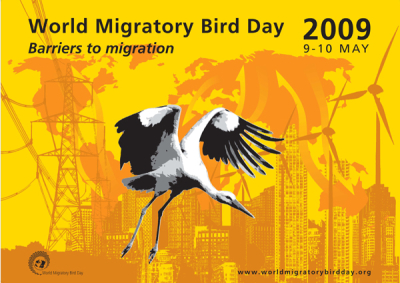World Migratory Bird Day This year on World Migratory Bird Day (May 9 and May 10) aims to raise awareness on some of man-made barriers to bird migration. Year by year in autumn and spring majestic flocks of migratory birds depart for their long journeys following the call of nature and the paths of their ancestors. For some, it is a long, exhaustive and often dangerous journey, stretching thousands of kilometers. Along their way migratory birds face a number of natural and man-made obstacles. They have to cope with scarcity of food, shrinking areas as stopover sites, predators, hostile weather, huge mountains and the expansion of the seas and deserts and other natural barriers. Yet, humans have created additional obstacles to further complicate their journeys. Each year the number of man-made structures such as power lines, wind farms, television and mobile phone transmission masts, glass windows, tall buildings and other structures continues to grow irrespective of the migratory routes and the important sites used by migratory birds. These man-made structures cause collisions that can result in fatalities. Many birds, especially those which migrate during the night, do not recognize these obstacles and collide with power lines, crash into glass windows or hit the rotating blades of wind turbines. They stay away from their regular stopover-sites when they are covered with wind farms or get off course when attracted by lights from communication masts and towers. Losses resulting from such bird-strikes account for huge numbers of dead and injured birds every year. This year World Migratory Bird Day (WMBD) aims to raise awareness on some of these man-made barriers to migration by encouraging national authorities, Non-Governmental Organisations (NGOs), clubs and societies, universities, schools and individuals around the world to organize events and awareness-raising programs which help draw attention to the many man-made obstacles migratory birds face during their migration. World Migratory Bird Day (WMBD) was launched in 2006 by the Secretariats of the African-Eurasian Waterbird Agreement and the Convention on Migratory Species, two United Nations Environment Programme-backed environmental treaties dedicated to the conservation of migratory waterbirds and the world's other migratory avian, terrestrial and marine species. With this year's theme, the organizers intend to help raise awareness on some of the man-made barriers migratory birds face during migration and provide a global platform for people and dedicated organizations to take action for the conservation of migratory birds. For more information please visit: www.worldmigratorybirdday.org 
Daiga Brakmane 20.04.2009. | 






